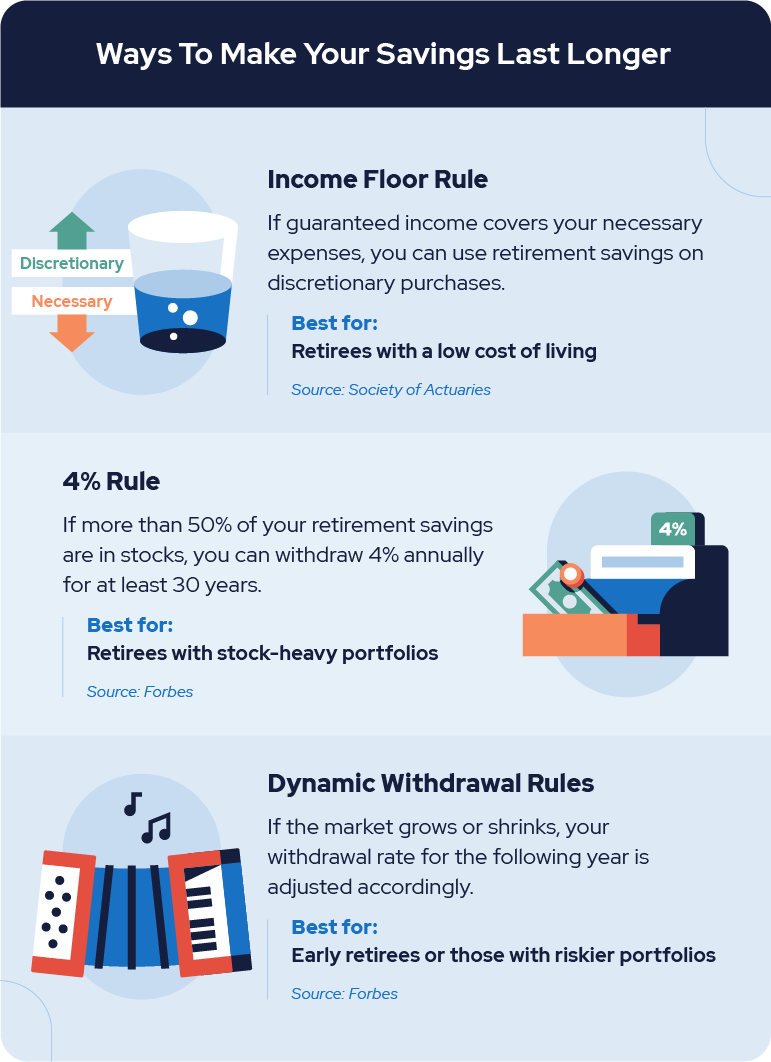The sooner you begin to save for retirement, the more financial security you’ll have during your golden years. To boost and conserve your retirement savings and understand some basic retirement investment strategies, read this article below.
Retirement Withdrawal Strategies
When investing in retirement accounts, it’s a good idea to follow self-imposed withdrawal rules to ensure you’re conserving your savings.
The 4% Rule
When making withdrawals from your retirement accounts, it’s a good idea to follow the four percent rule. This was a rule coined by William Bengen that asserts that it’s best to withdraw four percent of your retirement account annually in order to conserve your savings. This allows you to keep a consistent source of income without depleting your savings faster than they can grow.
That said, for this rule to be viable, you can’t just have money in a traditional savings account because those don’t grow significantly over time. Your money needs to be contained in stocks and bonds or a retirement investment vehicle like a 401(k) or Individual Retirement Account (IRA) for the four percent rule to be applicable.
Dynamic Withdrawal Rules
While the four percent rule is a more straightforward way to withdraw retirement savings, dynamic withdrawals might be the better option. That said, dynamic withdrawals take more mindfulness on your part since you need to monitor your market returns and adjust your withdrawal rate accordingly.
The basic concept of dynamic withdrawal rules is that if the market returns are up in a given year, you should withdraw a greater percentage of your retirement income each month. If market returns are down for a year, you should reduce your withdrawals by a similar amount.
Some specific dynamic withdrawal strategies that are good to reference include:
- The Yale Spending Rule
- Guyton-Klinger Rule
- Guardrail strategy
Since dynamic withdrawal rules tend to be more complicated, you might want to consider getting help from a financial advisor to understand them or to switch to a static spending strategy like the four percent rule.
Retirement Investing Tips
Investing in retirement accounts is easy once you do your research. Understand your options and follow the tips below to build your retirement fund.
Know the Different Types of Retirement Accounts
The first thing you should do before investing in retirement is research the different savings account options available. While some are offered through banks, other accounts are offered through your employer.
Many of these accounts, such as 401(k)s and IRAs, are tax-deferred — meaning you aren’t taxed on your account earnings or contributions. Once you withdraw funds, however, you’ll be susceptible to income tax.
Consider Investing In Annuities
Annuities are a type of insurance product that people often use to retire. They offer a steady stream of income during retirement at a monthly, quarterly, or annual rate. That said, you don’t invest in an annuity for profit. Annuities are more so a vehicle for financial security later in life.
Start Now
The earlier you start saving, the better off you will be when you retire. It’s a bad idea to ramp up your savings plan all at once only a couple of years before retirement. By calculating the amount of money you’ll need to retire down the road, you can create a realistic savings plan that you can contribute to little by little each month.
Another benefit of starting saving early is that you can invest in stocks and bonds with a higher risk tolerance. This essentially means that you can make riskier investments that yield greater returns over time. Once you are near retirement, your risk tolerance naturally gets lower since major losses could undermine your retirement savings, leaving you no chance to earn those funds back.
Understand Compound Interest
Compound interest takes place when the interest rate of your investment account earns interest itself. Basically, this means that as your funds increase, you earn more money through interest on the increased funds. It’s as if the interest you earn is reinvested back into your account to earn more interest.
Compound interest doesn’t always work for you, however. Compound interest can also impact the amount of money you owe on debts. This is why it’s important to pay off high-interest debts as fast as possible before the compounding interest causes you to owe much more than you did in the first place.
Choose the Right State to Retire
Tax rates vary based on each state. While the majority of states don’t tax Social Security benefits, oftentimes, retirement benefits are taxed as income. This means that your retirement savings might be lower than you think they are as a result of the tax rates of your location.
Luckily, there are states that don’t tax your retirement benefits at all. States like Alaska and Florida have no income tax, while states like Mississippi and New Hampshire have income tax but exempt retirement benefits from taxation.
But before you plan your move to a state with no income tax, understand that a higher cost of living could cancel out the benefit of living somewhere with lower taxes. Do your research to find a location that strikes a balance of the low cost of living and low tax rates to maximize your retirement savings.
Consider Delaying Social Security
The first year you can receive Social Security benefits is at age 62. For every year you delay these benefits; however, your monthly check will increase by about 8%. You can continue to do this until age 70. By then, you’ll be receiving checks significantly larger than what you would have received at 62.
Understand that this option might not be best if you don’t have a significant amount of extra money available at age 62. If you feel you need to rely on Social Security to get by, you probably don’t want to pinch pennies just to receive more funds in the future.
While saving and investing for retirement requires that you plan ahead, once you’ve done a little bit of research, the process becomes simple. Follow the tips above to accumulate a nest egg that will last you through your golden years.
If you’re looking for more retirement investment tips, check out the infographic below.
Please include attribution to Retireguide.com with this graphic.


